The right way to use Visual Timetables
I bet anyone whose ever had a specialist in to advise them how to support an autistic pupil has been told to use a visual timetable. I bet it’s written down as a strategy in almost every statement or EHCP for autistic pupils.
You might have a visual timetable on your classroom wall. You might remember to put up the schedule for the day, every day, and even to take off each picture as you finish each activity. You might be remembering to do this for a child’s individual visual timetable. Well done if you have. However, if you haven’t had them explained to you properly, it can easily seem as a lot of work for little reason…
I’d like to help you understand the full purpose of a visual timetable. It’s not just to let the child know what’s going on and in what order but it’s an important teaching tool. Here are some of the main teaching opportunities:
- Developing memory and recall skills. Seeing the structure of the day can help with memory skills for children who think better in pictures than in verbal language. The symbols can be retrieved from the ‘finished’ pocket to review the day and put things in time order.
- Teaching organisation and independence skills. The child should be managing their own timetable. That means self-checking what they should be doing and where they should be, managing the taking off of the symbols and putting them in the finished pocket themselves.
- Developing working memory skills – seeing what is on the timetable can make recalling what has been done in other lessons easier. This can be supported by a lesson schedule or subject diary.
- Executive functions such as planning, predicting, monitoring and timing can sometimes be difficult for autistic pupils. A visual timetable scaffolds those skills and most importantly the child can ‘self-check’ where they are up to. If your memory is poor and your anxiety high, then a visual timetable is THERE and easy to check. It doesn’t rely on the child having verbal skills or opportunity to ask an adult.
- Less reliance on an adult prompt. There can be a learned helplessness when a child gets too used to an adult verbally promoting them all the time. This is why know how and where to check something for themselves is a good skill to have. Especially thinking about them growing up and how there is likely to be less attention from an adult at Secondary school.
- A visual timetable can also let the child know when their sensory breaks are or unexpected events or changes are happening.
- You can prepare a ‘change’ symbol to support a child learning to cope with changes or unexpected events.
Some useful symbols for changes
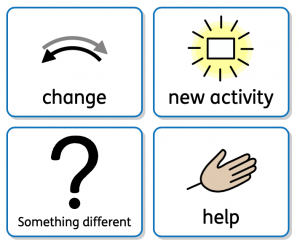
I sometimes see visual timetables as wallpaper, and by that I mean, they are pretty pictures on the wall – but then sometimes the pictures are not even that day’s schedule and the child hasn’t been taught to manage the timetable themselves. I might be told “Oh, we tried a visual timetable but it didn’t work,” Or “They don’t need a visual timetable, they’ve grown out of it,” but the pupil still has poor independence and organisation skills.
Visual timetables grow with the child. They should be age and developmentally appropriate. I have one – It’s a full term calendar on one sheet that I write in all my school visits, INSET sessions and meetings. It’s visual and I’d be very anxious (not to mention, totally lost) without it. Diaries and lists provide a similar visual aid to my life and how it is organised (or not!). If we want autistic pupils to be able to develop good organisation skills, a visual timetable can be a great start. Choose the right format for the child and you will get it right. We might start with objects of reference, use photos or symbols or colour coded words, and the format can develop as the child does. Sometimes teachers thing a child doesn’t need it anymore and take it away. Then the child’s behaviour and independence can begin to deteriorate. It is often the case that what they needed was an updated timetable rather than taking it away. It can surprise us how much the child was relying on their visual timetable. It is ok to have one all their lives – as they get older we teach them to self-manage their timetable more and develop their own formats if necessary. Like we do as adults with our diaries and lists.
AND IT DOES NOT MATTER WHETHER IT IS HORIZONTAL OR VERTICAL! Let’s dispel this myth, once and for all. Use whatever fits into your space and what the pupil can easily use. I have known staff who have worried about this so much because one professional said do it one way and another said do it the other way, that they didn’t actually start using the visual timetable for weeks because they were so worried about getting it wrong.
To share an example. Over the years I’ve worked with some pupils who were at risk of being excluded for behaviour. A visual timetable used to show them the lessons, ‘calm or choice times’, sensory breaks and, most importantly, when home time is, has regularly (along with other strategies) made a huge impact in helping the child navigate the day, reduce stress and anxiety and therefore reduce challenging behaviours. Honestly, it can sometimes be the pivotal strategy that makes all the difference for the child.
If you want to know more, there are lots more advice and examples in my book ‘How to support pupils with ASC In Primary Schools’ published by LDA.
I have Widgit ‘Communicate in Print’ software which I love for not only making visual timetables but also for supporting a pupil’s writing, reading and curriculum access.
This work is licensed under a Creative Commons Attribution-NoDerivatives 4.0 International License.

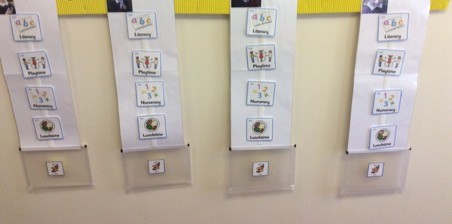


 pixabay.com
pixabay.com 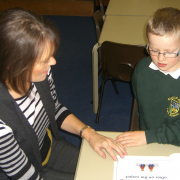 Lynn McCann
Lynn McCann 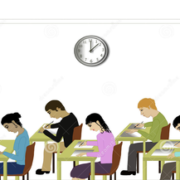
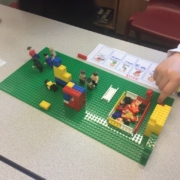
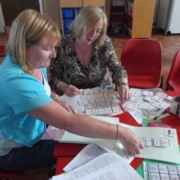
 Free from www.pixabay.com
Free from www.pixabay.com  Lynn McCann 2023
Lynn McCann 2023 

Trackbacks & Pingbacks
[…] a visual timetable and use it. Here you can read about why this can help children learn […]
[…] A visual timetable supports a person with ASC because they are often more visual than verbal thinkers. It is important that it is both developmentally appropriate and manged by the person themselves, if possible. We have often made visual timetables for KS2 and KS3 children as well as preschoolers. Some teachers have a class visual timetable, which can be good for all children, but remember the child with ASC may need their own. They teach a person the order of things, helps them learn about time, prepares them for events and how to organise themselves. A ‘FINISHED’ pocket to post symbols in once an event or activity is over, is important too. Learn how visual timetables can teach all kinds of things in this article from my blog. […]
Comments are closed.